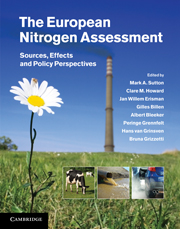Book contents
- Frontmatter
- Contents
- List of contributors
- Foreword
- Summary for policy makers
- Technical summary
- 1 Assessing our nitrogen inheritance
- Part I Nitrogen in Europe: the present position
- Part II Nitrogen processing in the biosphere
- 6 Nitrogen processes in terrestrial ecosystems
- 7 Nitrogen processes in aquatic ecosystems
- 8 Nitrogen processes in coastal and marine ecosystems
- 9 Nitrogen processes in the atmosphere
- Part III Nitrogen flows and fate at multiple spatial scales
- Part IV Managing nitrogen in relation to key societal threats
- Part V European nitrogen policies and future challenges
- Glossary
- Index
- References
6 - Nitrogen processes in terrestrial ecosystems
from Part II - Nitrogen processing in the biosphere
Published online by Cambridge University Press: 16 May 2011
- Frontmatter
- Contents
- List of contributors
- Foreword
- Summary for policy makers
- Technical summary
- 1 Assessing our nitrogen inheritance
- Part I Nitrogen in Europe: the present position
- Part II Nitrogen processing in the biosphere
- 6 Nitrogen processes in terrestrial ecosystems
- 7 Nitrogen processes in aquatic ecosystems
- 8 Nitrogen processes in coastal and marine ecosystems
- 9 Nitrogen processes in the atmosphere
- Part III Nitrogen flows and fate at multiple spatial scales
- Part IV Managing nitrogen in relation to key societal threats
- Part V European nitrogen policies and future challenges
- Glossary
- Index
- References
Summary
Executive summary
Nature of the problem
Nitrogen cycling in terrestrial ecosystems is complex and includes microbial processes such as mineralization, nitrification and denitrification, plant physiological processes (e.g. nitrogen uptake and assimilation) and physicochemical processes (leaching, volatilization). In order to understand the challenges nitrogen puts to the environment, a thorough understanding of all these processes is needed.
Approaches
This chapter provides an overview about processes relating to ecosystem nitrogen input and output and turnover. On the basis of examples and literature reviews, current knowledge on the effects of nitrogen on ecosystem functions is summarized, including plant and microbial processes, nitrate leaching and trace gas emissions.
Key findings/state of knowledge
Nitrogen cycling and nitrogen stocks in terrestrial ecosystems significantly differ between different ecosystem types (arable, grassland, shrubland, forests).
Nitrogen stocks of managed systems are increased by fertilization and N retention processes are negatively affected.
It is also obvious that nitrogen processes in natural and semi-natural ecosystems have already been affected by atmospheric Nr input.
Following perturbations of the N cycle, terrestrial ecosystems are increasingly losing N via nitrate leaching and gaseous losses (N2O, NO, N2 and in agricultural systems also NH3) to the environment.
- Type
- Chapter
- Information
- The European Nitrogen AssessmentSources, Effects and Policy Perspectives, pp. 99 - 125Publisher: Cambridge University PressPrint publication year: 2011
References
- 70
- Cited by



